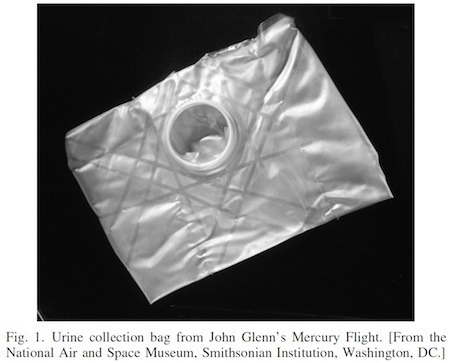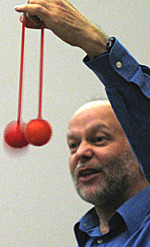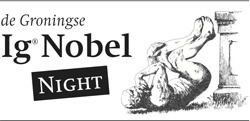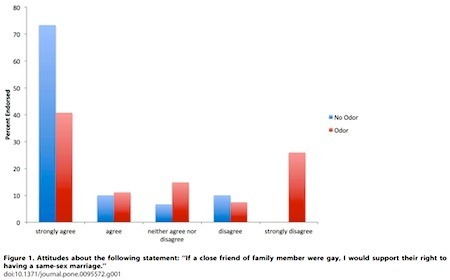Marc Abrahams's Blog, page 402
May 20, 2014
Forgotten Hardware: How to Urinate in a Spacesuit
 Pretty much everyone asks, at one time or another, “How do astronauts pee?” Hunter Hollins [pictured here] exerted considerable scholarship to provide a good answer, which you can read in Hollins’s study:
Pretty much everyone asks, at one time or another, “How do astronauts pee?” Hunter Hollins [pictured here] exerted considerable scholarship to provide a good answer, which you can read in Hollins’s study:
“Forgotten Hardware: How to Urinate in a Spacesuit,” Hunter Hollins, Advances in Physiology Education, vol. 37, 2013, pp. 123-128. The author, at the National Air and Space Museum, Smithsonian Institution, Washington, DC, reports:
“On May 5, 1961, astronaut Alan Shepard became the first American to fly in space. Although the National Aeronautics and Space Administration (NASA) had discounted the need for him to urinate, Shepard did, in his spacesuit, short circuiting his electronic biosensors. With the development of the pressure suit needed for high-altitude and space flight during the 1950s, technicians had developed the means for urine collection. However, cultural mores, combined with a lack of interagency communication, and the technical difficulties of spaceflight made human waste collection a difficult task. Despite the difficulties, technicians at NASA created a successful urine collection device that John Glenn wore on the first Mercury orbital flight on February 20, 1962….

“Although Glenn did not understand the physics and physiology of urination in space, he was wearing the first in a long series of NASA UCDs [urine collection devices]. As B.F. Goodrich had not been able to produce a successful UCD, McBarron and his team, consisting of Al Rochford and Joe Schmitt of the Manned Spaceflight Center Suit Laboratory, developed the first successful UCD used by the Mercury astronauts. The suit laboratory was responsible for ensuring that the astronauts were properly equipped (see Fig. 3). McBarron modified condoms to create an external catheter, which he referred to as a “roll-on-cuff” (see Fig. 4).”

Here’s a photo of John Glenn in his space suit:
Here he is, in later life, in an airplane:

Ig Nobel Night in Groningen, The Netherlands

 The ‘Nacht van Kunst & Wetenschap’ (Saturday, May 24, 2014) in Groningen, the Netherlands, will host an official Ig Nobel Night — with talks by four Ig Nobel Prize winners, and also a 24/7 Lecture competition.
The ‘Nacht van Kunst & Wetenschap’ (Saturday, May 24, 2014) in Groningen, the Netherlands, will host an official Ig Nobel Night — with talks by four Ig Nobel Prize winners, and also a 24/7 Lecture competition.
In four 20-minute sessions, Kees Moeliker (European Bureau Chief of the Annals of Improbable Research) will briefly tell about the history and impact of the Ig Nobel Prize, and he will introduce winners Chris McManus (pictured here), Pek van Andel and Bart Knols. They will each lecture about how and why they won their prize. Then scientist from Groningen University will present their field of research, giving (1) a clear description in 24 seconds, followed by (2) a summary of seven words that anyone can understands. These so-called 24/7 Lectures are a long running tradition at the annual Ig Nobel Prize Ceremony.
The line-up of Ig winners and 24/7 Lecturers is:
21:30 – 21:50h – Chris McManus; 24/7 Lectures: Wander Lowie & Kees Hummelen
22:00 – 22:20h – Pek van Andel; 24/7 Lectures: Janniko Georgiadis & Berend van de Kolk
23:40 – 00:00h – Bart Knols; 24/7 Battle: Christiaan Zuidema & Ellen van der Werf
00:10 – 00:30h – Chris McManus; 24/7 Battle: Marcel Broersma & Linda Steg (Ig-winners Bart Knols and Pek van Andel might perform again)
When: Saturday, May 24, 2014
Location: Der Aa Kerk, Akerkhof 2, Groningen, the Netherlands.
Tickets (for the entire Nacht van Kunst en Wetenschap): here.

May 19, 2014
A logical calculus of vomit stink, gay marriage, and political leaning
The logic and scope of this new study perhaps offer lessons for researchers in every field:
“Disgust and the Politics of Sex: Exposure to a Disgusting Odorant Increases Politically Conservative Views on Sex and Decreases Support for Gay Marriage,” Thomas G. Adams, Patrick A. Stewart [pictured here], John C. Blanchar, PLoS ONE, 9(5), May 5, 2014, e95572. (Thanks to investigator Marianne Lower for bringing this to our attention.) The authors, at the University of Arkansas, explain:
“[We] expected the foul disgust odorant, in this case butyric acid, which smells like vomit, to robustly engage the emotion of disgust and decrease approval of gay marriage….
“Participants were assigned to either a disgust odor condition or a control (no odor) condition. Ten minutes prior to participant arrival, an experimenter placed four drops of 99% butyric acid [20], [21] on two small cotton pads and hid these pads at the front and back of the room. Pads were replaced and the room aerated between experimental groups. Immediately upon entering the experimental room, all participants completed disgust ratings and socio-political opinion questions….
“The finding that belief in Biblical truth was greater among participants in the disgust odor condition was unexpected but is nonetheless consistent with previous work showing a relation between disgust and scrupulosity or being careful to avoid doing wrong….
“Odor induced conservative shifts concerning gay marriage were particularly robust.”
Here’s further detail from the study:
BONUS (possibly related, in some way): Aroxa’s butyric acid training sheets and capsules for wine experts-to-be, “Butyric, rancid, like baby vomit”:
BONUS: A little about butyric acid on the cheap:

Eating plants – is it wrong?
Vegetarians sometimes get challenged with questions along the lines of “If you think it’s unethical to eat animals, how about plants, maybe they have feelings too?” What are the ethical implications of/for a pea in a bowl of pea soup for example? Just such a question has been considered by Michael Marder, who is Ikerbasque Research Professor of Philosophy at the University of the Basque Country, Vitoria-Gasteiz.
“
Dialectically speaking, a bowl of pea soup consumed by a human being negates the independent, external existence of peas but, in so doing, it also elevates them, to the extent that they now come to fulfill a higher purpose as a source of energy for rational creatures. Along with the actual vegetal beings (the peas), their entire being is consumed without remainder, in that it gets assigned to a single end, extraneous to the plants themselves. Eating plants becomes an intermediary step toward digesting vegetal ontology, just as the secret goal of consumerism is not to possess this or that object but to consume the world in its totality.”
see: ‘Is It Ethical to Eat Plants’ in the journal Parallax, 19(1), 2013, pp. 29-37 (the special issue bon appétit, on the ‘complexities of the alimentary’)
Professor Marder has made a full copy of the paper available here:
He is currently working on a book entitled ‘The Philosopher’s Plant: An Intellectual Herbarium’ which examines Heidegger’s Apple Tree,
Hegel’s Grapes, Kant’s Tulip, Leibniz’s Blades of Grass, Avicenna’s Celery,
Maimonides’s Palm Tree, St. Augustine’s Pear, Plotinus’ Anonymous ‘Great Plant’, Aristotle’s Wheat, and Plato’s Plane Tree.
Also see: (on Improbable Research)
NOTE: The 2008 Ig Nobel Peace Prize was awarded to The Swiss Federal Ethics Committee on Non-Human Biotechnology (ECNH) and the citizens of Switzerland for adopting the legal principle that plants have dignity. [REFERENCE: "The Dignity of Living Beings With Regard to Plants. Moral Consideration of Plants for Their Own Sake"]

Fitness: round holes and square holes, pegged
Wolfram Mathworld bores down into a much-discussed-by-others-but-usually-idly question about pegs and holes:
The answer to the question “which fits better, a round peg in a square hole, or a square peg in a round hole?” can be interpreted as asking which is larger, the ratio of the area of a circle to its circumscribed square, or the area of thesquare to its circumscribed circle? In two dimensions, the ratios are
and
, respectively. Therefore, a round peg fits better into a square hole than a square peg fits into a round hole (Wells 1986, p. 74).
…
REFERENCES:
Singmaster, D. “On Round Pegs in Square Holes and Square Pegs in Round Holes.” Math. Mag. 37, 335-339, 1964.
Sloane, N. J. A. Sequence A127454 in “The On-Line Encyclopedia of Integer Sequences.”
Wells, D. The Penguin Dictionary of Curious and Interesting Numbers. Middlesex, England: Penguin Books, p. 74, 1986.
[via Cliff Pickover]

May 18, 2014
Double-Ig slime-mild winner studies backwards-dead-end behavior of paramecia
 Toshiyuki Nakagaki [pictured here], who has been awarded two Ig Nobel Prizes for studying the apparently intelligent behavior of slime mold, has (with colleagues) published a new study of apparently intelligent behavior in a very different creature:
Toshiyuki Nakagaki [pictured here], who has been awarded two Ig Nobel Prizes for studying the apparently intelligent behavior of slime mold, has (with colleagues) published a new study of apparently intelligent behavior in a very different creature:
“Attempts to retreat from a dead-ended long capillary by backward swimming in Paramecium,” Itsuki Kunita, Shigeru Kuroda, Kaito Ohki and Toshiyuki Nakagaki, Frontiers in Microbiology, 5:270, epub May 16, 2014. The authors, at Hokkaido University and Future University Hakodate, Japan, report:
“It is not trivial to study how unicellular organisms tackle a problem, as they often try different behaviors instead of previously unsuccessful behaviors to solve dilemmas. One of the most important issues to be addressed here is what types of behavior can be induced and how such behavioral options appear in terms of information processing in the cell. It is interesting to identify whether mechanisms of information processing are based on mechanical equations of motion, because in some sense the physical basis of an adaptation or learning process could be suggested….
“We have observed how the ciliate Paramecium attempts to retreat from the dead-end of a long capillary that is too narrow for turning. After many trial-and-error episodes of short-term backward swimming (SBS), which is the conventional avoidance behavior exhibited in free swimming when an obstacle is faced, long-term backward swimming (LBS) that lasted five to ten times longer was developed. LBS may have a beneficial effect for complete withdrawal from the capillary space, although in our experiment it was impossible for the organism to do so due to the capillary length. In order to identify a physically possible mechanism for LBS, we propose model equations for the membrane potential of Hodgkin-Huxley type, which describe the control of ciliary movement.”
Here’s further detail from the study:
Nakagaki’s two Ig Nobel Prizes:
2010 TRANSPORTATION PLANNING PRIZE: Toshiyuki Nakagaki, Atsushi Tero, Seiji Takagi, Tetsu Saigusa, Kentaro Ito, Kenji Yumiki, Ryo Kobayashi of Japan, and Dan Bebber, Mark Fricker of the UK, for using slime mold to determine the optimal routes for railroad tracks. REFERENCE: “Rules for Biologically Inspired Adaptive Network Design,” Atsushi Tero, Seiji Takagi, Tetsu Saigusa, Kentaro Ito, Dan P. Bebber, Mark D. Fricker, Kenji Yumiki, Ryo Kobayashi, Toshiyuki Nakagaki, Science, Vol. 327. no. 5964, January 22, 2010, pp. 439-42. VIDEO:
2008 COGNITIVE SCIENCE PRIZE. Toshiyuki Nakagaki of Hokkaido University, Japan, Hiroyasu Yamada of Nagoya, Japan, Ryo Kobayashi of Hiroshima University, Atsushi Tero of Presto JST, Akio Ishiguro of Tohoku University, and Ágotá Tóth of the University of Szeged, Hungary, for discovering that slime molds can solve puzzles. REFERENCE: “Intelligence: Maze-Solving by an Amoeboid Organism,” Toshiyuki Nakagaki, Hiroyasu Yamada, and Ágota Tóth, Nature, vol. 407, September 2000, p. 470. [VIDEO]

Rumors that Ig Nobel winner Gideon Gono will be Zimbabwe’s next president
Various press outlets in Zimbabwe and neighboring countries are suggesting that Ig Nobel Prize winner Gideon Gono will be the next president of Zimbabwe, if and when Robert Mugabe, the current president, ever leaves office. Dr. Gono recently stepped down from his position as governor of Zimbabwe’s Reserve Bank.
Dr. Gono was awarded the 2009 Ig Nobel Prize for mathematics, for giving people a simple, everyday way to cope with a wide range of numbers — from very small to very big — by having his bank print bank notes with denominations ranging from one cent ($.01) to one hundred trillion dollars ($100,000,000,000,000).

Here are a few of the news reports:
ZimDaily [April 20, 2014]: “Gideon Gono, 54, the former governor of Zimbabwe’s reserve bank, has emerged as the favourite to succeed Robert Mugabe as president. As his health begins to fade, Mugabe, 90, who has ruled Zimbabwe for 34 years, has begun to cast around for a political heir….”
Allafrica.com [May 2, 2014]: “In March, rumour circulated that ZANU PF leader Robert Mugabe was seriously considering sacking him and replacing him with blue-eyed boy Gideon Gono….”
The Telescope News [May 2, 2014]: “[The] media in Harare has been awash with reports about Grace pushing for former reserve bank chief, Gideon Gono, to replace Mugabe. The first lady is said to have become interested in the country’s politics after it emerged that a section within the ruling party was pushing for Mugabe, to quit before his five-year term of office expired in 2018. Central Intelligence Organisation (CIO), operatives have been leaking information about the close ties between the Mugabe and Gono families, amid reports that the two families are exchanging frequent personal visits, with many inside Zanu PF interpreting this as an indication that, the ailing leader is now grooming Gono….”

Measurement: Two of 30 babies will one day sing and dance, maybe
Infants are not famous for being skilled consumers or producers of music. This study suggests that that lack of fame is justified for 28 of 30 babies:
“Precursors of Dancing and Singing to Music in Three- to Four-Months-Old Infants,” Shinya Fujii [pictured here], Hama Watanabe, Hiroki Oohashi, Masaya Hirashima, Daichi Nozaki, Gentaro Taga, PLoS ONE, 9(5), 2014, e97680. The authors, at Sunnybrook Research Institute, Toronto, Canada, the University of Tokyo, and the Japan Society for the Promotion of Science, Tokyo, explain:
“Here we report limb movements and vocalizations in three- to four-months-old infants while they listened to music and were in silence…. Intriguingly, however, there were two infants [of the 30 infants we examined] who demonstrated striking increases in the rhythmic movements via kicking or arm-waving around the musical tempo during listening to music. Monte-Carlo statistics with phase-randomized surrogate data revealed that the limb movements of these individuals were significantly synchronized to the musical beat.”
Here’s detail from the study:
This is one of the two songs used in the study:

May 17, 2014
Officially dead candidates edge closer to being elected
The Times of India reports, on May 16, 2014:
Dead men poll-vault to life in east UP
AZAMGARH: The ‘living dead’ of eastern Uttar Pradesh have been using polls as a means to show to the world that they are alive. They are all candidates of Mritak Sangh (dead people group) which is fighting for justice for those who have been fraudulently declared dead by their relatives in panchayat and revenue records to claim properties.
This time the papers of Mritak Sangh’s Azamgarh candidate ‘Murda’ Ram Avatar Yadav were rejected but that hasn’t deterred its president Lal Bihari ‘Mritak’ who keeps innovating on ways to bring these dead people alive…. He proudly flaunted his title ‘Mritak’ meaning dead. Bringing dead people alive is now a full-time occupation and also obsession for this 55-year-old from Sanjarpur….
[He] contested for the first time in Allahabad Lok Sabha by-election in 1988 against VP Singh, Kanshi Ram and Sunil Shaastri. The next stop was Amethi in 1989 – against Rajiv Gandhi and Rajmohan Gandhi. Thereafter he contested six more elections – from assembly to local bodies – before he was finally declared alive on June 30, 1994….
His work got him the Ig Nobel from Harvard in 2003. But as he could not travel to Harvard at that time, he was formally honoured in February this year at BITS Pilani at the conclave of Ig Nobel winners…..

Inspired by the possibility that catfish caused earthquakes
At one time, some people believed that giant catfish caused earthquakes in Japan. This belief led to the production of artworks of those catfish in thought and action. The University of British Columbia has, in its art collection, some of these works. They explain:
A number of the prints in this collection feature catfish, known as namazu in Japanese. These can be incredibly confusing when first encountered, both in the “What is that thing?” way (as they frequently have both arms and legs) and the “How is this related to disasters?” way. Things become clearer upon discovering that a giant namazu was blamed for the 7.0 earthquake that happened below Edo (now known as Tokyo) in November, 1855. Just days after this event ukiyo-e woodblock prints depicting giant catfish began to be produced and sold.
The Namazu was supposed to be a giant catfish who lived underground, pinned beneath the foundation stone of a local shrine by the god Kashima. However, when Kashima failed at his task (due to being at a gathering for various gods) the Namazu was able to thrash around and cause much destruction in the form of earthquakes.
Here’s a painting that depicts, says the UBC web site, a “song to ward off earthquakes caused by catfish”:
(HT Mitch Fraas)
UPDATE: The History of Geology web site explores the subject in an article called “Namazu: The Earthshaker“, by @David_Bressan. (Thanks to @sageaenna for bringing it to our attention.) FURTHER UPDATE TO THAT UPDATE: “An Essential Field Guide to North American Earthquake Beasts”
FUN FACT: In 1994 we awarded an Ig Nobel Prize in physics to a government agency “for its seven-year study of whether earthquakes are caused by catfish wiggling their tails.” However… we later discovered that the documentation for that was suspect. We had relied entirely on press accounts (from usually-reliable sources). When we found ourselves unable to verify those press reports, we retracted that prize. That incident taught us to be more careful about doing our homework before selecting winners.

Marc Abrahams's Blog
- Marc Abrahams's profile
- 14 followers











